SCIENCE INSPIRED BY NATURE
SMA® PRO First Infant Milk
A whey dominant, nutritionally complete infant milk suitable from birth. It can be used for infants who are not being breastfed or for those being combination fed.
SMA® PRO First infant Milk contains 2'FL*.
Product description
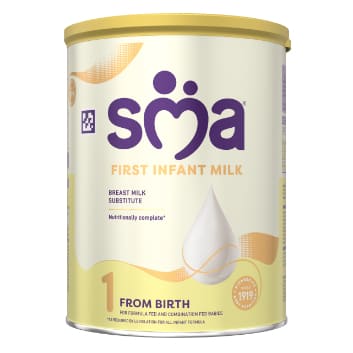
Appropriate growth
- Clinically proven to achieve growth rate comparable with a breastfed baby.1
- Contains closer amino acid profile to that of breast milk, which is thought to help support appropriate growth2,3
Immunity
- Contains vitamin D which contributes to the normal functioning of baby’s immune system.4
- Contains 2’FL* Human Milk Oligosaccharide (HMO): Research suggests that infants fed a formula supplemented with 2’FL* HMO had immune markers closer to breast-fed infants5
2’FL HMO is the most abundant oligosaccharide found in breast milk.6
To find out more about the role of HMOs in breast milk click here
Infant poo is a topic that is frequently discussed between parents and health care professionals. To find out more about infant poo and what to expect, click here.
The growth pattern of a breastfed baby is associated with improved health outcomes.7, 8 Breastfed babies tend to grow more slowly than bottle-fed babies.9 Protein is one of the main drivers of growth, and the quantity and quality of protein in breast milk is ideal to support appropriate growth.
Halal Certified.
Data card
Formats
SMA® PRO First Infant Milk is available in a variety of formats for home and hospital use:
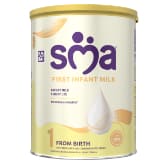
800 g powder
The scoop is provided under the lid. It can be stored in suspension inside the can.
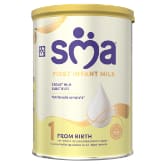
400 g powder
Also available in a smaller 400 g size can.
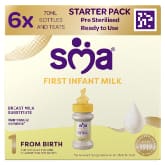
Starter pack
6 x 70 ml plastic bottles and NUK® orthodontic pre-sterilised teats.
No sterilising required. Disposable teats, screw directly onto the bottle.
(Available in UK only)
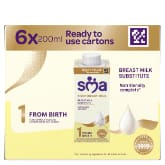
Multipack
6 x 200 ml Ready-to-Use cartons with a screwcap. Easy to open and pour and once open can be kept in the fridge for up to 24 hours.

Liquid milk (1 L carton)
Ready to Use liquid milk available in a
1 litre resealable carton, which is easy to pour and can be kept in the fridge up to 48 hours after opening.
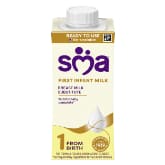
Liquid milk (200 ml carton)
200 ml Ready to Use resealable carton, which is easy to pour and can be kept in the fridge for up to 24 hours.
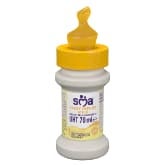
70 ml bottle
For hospital use only.
NHS catalogue code (UK only): ABT082
United Drug Wholesale order code (Ireland only): 12600991
Comparison charts
SMA® PRO First Infant Milk – developed to more closely match the composition of breast milk – in comparison with Aptamil, Cow & Gate and HiPP Organic first infant milks.
POWDER ONLY
| Breast milk | SMA® PRO First Infant Milk2 | Aptamil Profutura3 | Aptamil First Infant Milk4 | Cow & Gate First Infant Milk5 | HiPP Organic First Infant Milk6 | |
|---|---|---|---|---|---|---|
|
Non-nutritive biological factors (hormones, enzymes, growth factors etc |
||||||
|
Protein levels per 100 ml |
Varies |
1.24 g* |
1.3 g |
1.3 g |
1.3 g |
1.25 g |
|
Protein (whey:casein) ratio |
60:40 |
70 : 30 |
60 : 40 |
50 : 50 |
60 : 40 |
60 : 40 |
|
Meta-analysis demonstrating growth comparable with a breastfed baby |
n/a |
|||||
|
Contains 2'FL |
Preparation
How to open and prepare your baby's feed – powder (800 g and 400 g)
While this product is made under strict hygienic conditions, it is not sterile. Failure to follow instructions on preparation and storage may make your baby ill.

Pull the safety seal and open the lid. The scoop is provided under the lid. Lift the tab, pull on the foil seal, carefully and safely remove the seal and dispose of it.

Wash hands well. Wash and sterilise all utensils according to manufacturers’ instructions.

Boil 1 litre of fresh tap water. Allow boiled water to cool for no more than 30 minutes. Measure the required amount of water (see feeding guide) into a sterilised bottle, carefully – the water is hot. Do not use artificially softened or repeatedly boiled water.

Using only the scoop provided, add the correct number of scoops of powder (see feeding guide), levelling off each scoop with the back of a clean, dry knife. Store the scoop in suspension inside the can and replace lid.

Place the sterilised teat and cap on the bottle and shake well until powder is fully dissolved. Cool bottle under cold running water or in a bowl or jug of cold water until lukewarm, do not immerse the teat. Test temperature by shaking a few drops onto the inside of your wrist.
Preparing your baby's feed – liquid (70 ml Ready-to-Use)
Failure to follow instructions on preparation and storage may make your baby ill.

Wash hands well.

SMA® PRO First Infant Milk 70 ml can be fed at room temperature. If required to heat, stand the bottle in warm water.

Shake bottle well and remove the cap and aluminium foil, unwrap SMA® NUK® orthodontic pre-sterilised teat and holding the ring, screw directly onto the bottle (as per on pack instructions).

If warmed, test temperature by shaking a few drops of milk onto the inside of your wrist – milk should be lukewarm.
Preparing your baby’s feed – liquid (1 litre & 200 ml Ready-to-Use)
Failure to follow instructions on preparation and storage may make your baby ill.

Wash hands well. Wash and sterilise all utensils according to manufacturers' instructions.

If carton is damaged in any way, do not use. Shake carton well and unscrew cap. Pour desired amount into a sterilised bottle and add sterilised teat and cap. Replace plastic cap on carton.

SMA® PRO First Infant Milk can be fed at room temperature. If required to heat, stand filled bottle in warm water, do not immerse the teat.

Before feeding shake the bottle well. If warmed, test temperature by shaking a few drops onto the inside of your wrist – milk should be lukewarm.
Feeding guide
Feeding guide – powdered milk
|
Feeding guide birth – 12 months |
||||||
|
Approx. age of baby |
Approx. weight of baby |
Preparation for single feeds |
Feeds in 24 hours |
|||
|
Cooled, freshly boiled water |
||||||
|
kg |
lb |
Level scoops |
ml |
fl. oz. (approx.) |
||
|
Birth – 2 weeks |
3.4 |
7½ |
3 |
90 |
3 |
6 |
|
2 – 4 weeks |
3.7 |
8 |
4 |
120 |
4 |
6 |
|
4 – 8 weeks |
4.2 |
9¼ |
4 |
120 |
4 |
6 |
|
2 months |
5.3 |
11¾ |
5 |
150 |
5 |
5 |
|
3 months |
6.1 |
13½ |
6 |
180 |
6 |
5 |
|
4 months |
6.7 |
14¾ |
6 |
180 |
6 |
5 |
|
6 months |
7.6 |
16¾ |
8 |
240 |
8 |
4 |
|
7 – 12 months |
- |
- |
7 |
210 |
7 |
3 |
This table is a guide only; a baby may need more or less than the volumes stated. Caregivers should consult their healthcare professional if more advice is needed. Remember, a baby should be fed on demand. Mix 1 scoop of powder to 30 ml (approx. 1 fl. oz.) of water. Approx. 186 scoops per can (applicable to 800 g can only). 1 scoop = 4.3 g.
Feeding guide – liquid milk
|
Feeding guide birth – 12 months |
|||||
|
Approx. age of baby |
Approx. weight of baby |
Size of feed |
Feeds in 24 hours |
||
|
kg |
lb |
ml |
fl. oz. (approx.) |
||
|
Birth – 2 weeks |
3.4 |
7½ |
100 |
3½ |
6 |
|
2 – 4 weeks |
3.7 |
8 |
130 |
4½ |
6 |
|
4 – 8 weeks |
4.2 |
9¼ |
130 |
4½ |
6 |
|
2 months |
5.3 |
11¾ |
170 |
6 |
5 |
|
3 months |
6.1 |
13½ |
200 |
7 |
5 |
|
4 months |
6.7 |
14¾ |
200 |
7 |
5 |
|
6 months |
7.6 |
16¾ |
250 |
8½ |
4 |
|
7 – 12 months |
- |
- |
200 |
7 |
3 |
This table is a guide only; a baby may need more or less than the volumes stated. Caregivers should consult their healthcare professional if more advice is needed. Remember, a baby should be fed on demand.
Important feeding information
SMA® PRO First Infant Milk powder – 800 g and 400 g can
|
|
Do not add extra powder or water to make the feeds stronger or weaker and do not press powder into scoop. Using too much or too little powder can make your baby ill. |
|
|
We recommend preparing each feed in individual bottles when required. |
|
|
For hygienic reasons, discard unfinished feed in the bottle as soon as possible. |
|
|
For older babies, made-up formulae can be added to food. |
|
|
Do not alter or add to formulae unless medically directed. |
|
|
Do not warm feeds in a microwave, hot spots may occur and cause scalding. |
|
|
Remember, cows' milk should not be used as a drink during the first year. |
SMA® PRO First Infant Milk Starter Pack – 70 ml bottle
|
|
Special Safety Feature – Reject bottle if the foil under cap is missing or damaged prior to opening. |
|
|
Check best before date. |
|
|
After opening use immediately or store in the fridge (5 ºC or below) for up to 24 hours. |
|
|
For hygienic reasons, discard unfinished feed as soon as possible, and always within 1 hour. |
|
|
After use, discard bottle, teat and remaining contents. Bottles and teats are for single use only. |
|
|
Do not alter or add to formulae unless medically directed. |
|
|
Do not microwave, hot spots may occur and cause scalding. |
|
|
Remember, cows' milk should not be used as a drink during the first year. |
|
|
Do not freeze. |
Important teat information for the child’s safety and health – WARNING!
|
|
Teats are produced from natural rubber latex which may cause allergic reactions. |
|
|
Disposable teat (for single use only). |
|
|
This NUK® disposable orthodontic pre-sterilised teat is a size 1 teat (appropriate for babies from 0–6 months) with a feed hole suitable for infant milk. Use with SMA® PRO First Infant Milk 70 ml bottles. |
|
|
Give your baby’s feed only in the quantities and concentrations recommended by the manufacturer. |
|
|
Always check the food temperature before feeding. |
|
|
Always use this product with adult supervision. |
|
|
Continuous and prolonged sucking of fluids may cause tooth decay. |
|
|
Never use feeding teats as a soother. |
|
|
Teat expiry date: See individual teat. |
|
|
Do not dip in medicine. |
|
|
The NUK® disposable orthodontic pre-sterilised teat (manufactured for SMA® Nutrition) conforms to the requirements of EN14350. |
SMA® PRO First Infant Milk liquid – 1 litre Tetra-Pak®
|
|
Check best before date. |
|
|
Once open, reseal carton and store only in the fridge (5 ºC or below). Consume within 48 hours. |
|
|
For hygienic reasons, discard unfinished feed in the bottle as soon as possible, and always within 1 hour. |
|
|
For older babies, ready to use formulae can be added to food. |
|
|
Do not alter or add to formulae unless medically directed. |
|
|
Do not warm feeds in a microwave, hot spots may occur and cause scalding. |
|
|
Remember, cows' milk should not be used as a drink during the first year. |
|
|
Do not freeze. |
SMA® PRO First Infant Milk liquid – 200 ml Tetra-Pak
|
|
Check best before date. |
|
|
Once open, reseal carton and store only in the fridge (5 ºC or below). Consume within 24 hours. |
|
|
For hygienic reasons, discard unfinished feed in the bottle as soon as possible, and always within 1 hour. |
|
|
For older babies, ready to use formulae can be added to food. |
|
|
Do not alter or add to formulae unless medically directed. |
|
|
Do not warm feeds in a microwave, hot spots may occur and cause scalding. |
|
|
Remember, cows' milk should not be used as a drink during the first year. |
|
|
Do not freeze. |
-
Alexander DD et al. Growth of infants consuming whey-predominant term infant formulas with a protein content of 1.8g/100kcal: a multi-center pooled analysis of individual participant data. Am J Clin Nutr 2016; 104: 1083–1092
-
Kirchberg FF, Harder U, Weber M, Grote V, Demmelmair H, Peissner W, et al. Dietary protein intake affects amino acid and acylcarnitine metabolism in infants aged 6 months. J Clin Endocrinol Metab. 2015;100(1):149-58.
-
Nestle data on file, 2018: Batch analysis of amino acid composition in SMA PRO First Infant Milk, Human Milk and Aptamil First Infant Milk, 2018
-
Scientific Opinion on the substantiation of a health claim related to Vitamin D and contribution to the normal function of the immune system pursuant to Article 14 of Regulation (EC) No. 1924/2006. EFSA Journal 2015; 13(5);4906
-
Goehring KC et al. Similar to Those Who Are Breastfed, Infants Fed a Formula Containing 2’- Fucosyllactose Have Lower Inflammatory Cytokines in a Randomized Controlled Trial J Nutr. 2016;146:2559–2566.
-
Vandenplas et al., Human Milk Oligosaccharides: 2-Fucosyllactose (2-FL) and Lacto-N-Neotetraose (LNnT) in Infant Formula. Nutrients 2018, 10, 1161
-
WHO Multicentre Growth reference Study group Acta Paediatr Suppl 2006; 450: 71H15.
-
Baird J et al Being big or growing fast: systematic review of size and growth in infancy and later obesity BMJ 2008; 331: 929.
-
Kramer MS et al Feeding effects on growth during infancy J Pediatr 2004; 145:500–505
-
American Academy of Pedatrics C.o.N. 1988 Clinical testing of infant formulas with respect to nutritional suitability for term infants. Prepared under FDA contract 223-86-2117.
-
SMA PRO First Infant Milk datacard.
-
Aptamil First Infant milk datacard. Available at https://www.nutricia.co.uk/hcp/pim-products/aptamil-first-infant-milk-with-pronutra-advance-powder.html (Accessed January 2021
-
Koletzko et al Lower Protein in infant formula is associated with lower weight up to 2y: a randomized clinical trial. Am J Clin Nutr 2009; 89: 1836–45.
-
Weber M et al Lower protein content in infant formula reduces BMI and obesity risk at school age: follow-up of a randomized trial Am J Clin Nutr 2014;99:1041–51
*2'FL: structurally identical human milk oligosaccharides, not sourced from breast milk
IMPORTANT NOTICE:
The World Health Organisation (WHO) has recommended that pregnant women and new mothers be informed on the benefits and superiority of breastfeeding – in particular the fact that it provides the best nutrition and protection from illness for babies. Mothers should be given guidance on the preparation for, and maintenance of, lactation, with special emphasis on the importance of a well-balanced diet both during pregnancy and after delivery. Unnecessary introduction of partial bottle-feeding or other foods and drinks should be discouraged since it will have a negative effect on breastfeeding. Similarly, mothers should be warned of the difficulty of reversing a decision not to breastfeed. Before advising a mother to use an infant formula, she should be advised of the social and financial implications of her decision: for example, if a baby is exclusively bottle-fed, more than one can (400 g) per week will be needed, so the family circumstances and costs should be kept in mind. Mothers should be reminded that breast milk is not only the best, but also the most economical food for babies. If a decision to use an infant formula is taken, it is important to give instructions on correct preparation methods, emphasising that unboiled water, unsterilised bottles or incorrect dilution can all lead to illness.






